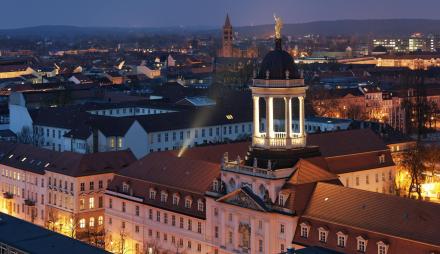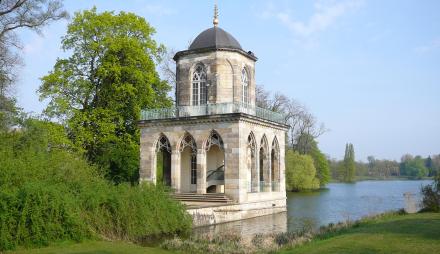
The term Alter Markt historically refers to the area surrounding St. Nicholas Church, extending to the formerly built-up waterfront along the Alte Fahrt. According to 19th-century eyewitnesses, it was once one of the most beautiful squares in Europe. Since reunification, discussions, plans, and designs have sought to restore its former grandeur and reintegrate the ensemble into a coherent urban structure.
As the heart of Potsdam, the Alter Markt was designed in the mid-18th century under Frederick the Great as an Italian-style square near the Havel River. The Roman ambiance is further emphasized by the marble obelisk, erected in 1753 and later altered in 1979. After only four buildings of the historic ensemble survived the bombing of April 14, 1945, the ruins of the City Palace were demolished in 1959/60. Following the reconstruction of the Fortunaportal in 2002, the new state parliament building was erected on the site.
Old Town Hall (Altes Rathaus)
The town hall has always stood at this location, though its appearance has changed multiple times. Around 1755, at the request of Frederick the Great, Potsdam’s fourth town hall was built based on designs by architects Jan Bouman and Christian Ludwig Hildebrandt. Its inspiration was a 16th-century design by Andrea Palladio for the Palazzo Angarano near Vicenza.
The sculptural column architecture and life-sized statues adorning the attic level gave the building a grand, palace-like appearance reminiscent of Italian façades. The prominent round temple structure of the drum, which was at times used as a prison, supports a tiered stone dome topped by a statue of Atlas—an element the king personally selected, inspired by the Amsterdam Town Hall.
From 1840, the town’s savings bank (Sparkasse) was housed in the Altes Rathaus, and in the early 20th century, the Potsdam Museum Association used it for special exhibitions. The baroque core building and its extensions were destroyed by fire in 1945. Between 1960 and 1966, the town hall was rebuilt as a cultural center. The restored baroque structure was connected by a modern extension to the Knobelsdorff House, an early neoclassical work from 1750, creating a harmonious architectural ensemble.
Restoration
Following an extensive restoration from 2010 to 2012, the Potsdam Museum returned to its original location in the Altes Rathaus, displaying valuable exhibits on the city’s history. The renovation was funded by urban development grants from the federal, state, and local governments, as well as support from the German Federal Ministry for the Environment, Nature Conservation, Building, and Nuclear Safety, the State of Brandenburg, and the State Capital Potsdam.
Video
Potsdam-based journalist Kristina Tschesch created a video about the Altes Rathaus at Alter Markt (in German). Today, the Altes Rathaus houses the Potsdam Museum – Forum for Art and History.
Links
Address
Stadtplatz Alter Markt
Alter Markt
14469 Potsdam
Germany



